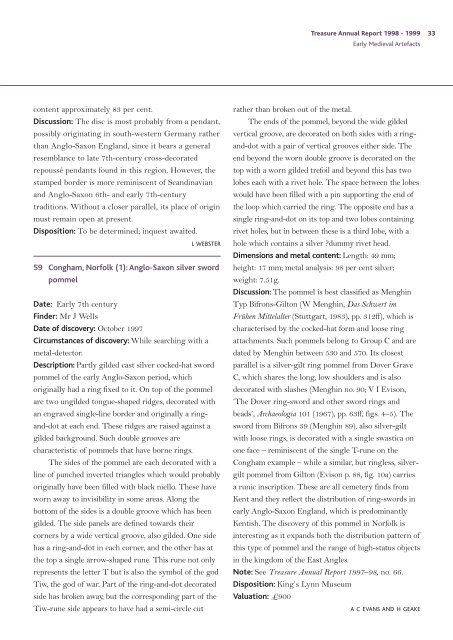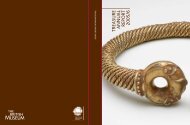Treasure Annual Report 1998-1999 - Portable Antiquities Scheme
Treasure Annual Report 1998-1999 - Portable Antiquities Scheme
Treasure Annual Report 1998-1999 - Portable Antiquities Scheme
Create successful ePaper yourself
Turn your PDF publications into a flip-book with our unique Google optimized e-Paper software.
content approximately 83 per cent.<br />
Discussion: The disc is most probably from a pendant,<br />
possibly originating in south-western Germany rather<br />
than Anglo-Saxon England, since it bears a general<br />
resemblance to late 7th-century cross-decorated<br />
repoussé pendants found in this region. However, the<br />
stamped border is more reminiscent of Scandinavian<br />
and Anglo-Saxon 6th- and early 7th-century<br />
traditions. Without a closer parallel, its place of origin<br />
must remain open at present.<br />
Disposition: To be determined; inquest awaited.<br />
L WEBSTER<br />
59 Congham, Norfolk (1): Anglo-Saxon silver sword<br />
pommel<br />
Date: Early 7th century<br />
Finder: Mr J Wells<br />
Date of discovery: October 1997<br />
Circumstances of discovery: While searching with a<br />
metal-detector.<br />
Description: Partly gilded cast silver cocked-hat sword<br />
pommel of the early Anglo-Saxon period, which<br />
originally had a ring fixed to it. On top of the pommel<br />
are two ungilded tongue-shaped ridges, decorated with<br />
an engraved single-line border and originally a ringand-dot<br />
at each end. These ridges are raised against a<br />
gilded background. Such double grooves are<br />
characteristic of pommels that have borne rings.<br />
The sides of the pommel are each decorated with a<br />
line of punched inverted triangles which would probably<br />
originally have been filled with black niello. These have<br />
worn away to invisibility in some areas. Along the<br />
bottom of the sides is a double groove which has been<br />
gilded. The side panels are defined towards their<br />
corners by a wide vertical groove, also gilded. One side<br />
has a ring-and-dot in each corner, and the other has at<br />
the top a single arrow-shaped rune. This rune not only<br />
represents the letter T but is also the symbol of the god<br />
Tiw, the god of war. Part of the ring-and-dot decorated<br />
side has broken away, but the corresponding part of the<br />
Tiw-rune side appears to have had a semi-circle cut<br />
<strong>Treasure</strong> <strong>Annual</strong> <strong>Report</strong> <strong>1998</strong> - <strong>1999</strong> 33<br />
Early Medieval Artefacts<br />
rather than broken out of the metal.<br />
The ends of the pommel, beyond the wide gilded<br />
vertical groove, are decorated on both sides with a ringand-dot<br />
with a pair of vertical grooves either side. The<br />
end beyond the worn double groove is decorated on the<br />
top with a worn gilded trefoil and beyond this has two<br />
lobes each with a rivet hole. The space between the lobes<br />
would have been filled with a pin supporting the end of<br />
the loop which carried the ring. The opposite end has a<br />
single ring-and-dot on its top and two lobes containing<br />
rivet holes, but in between these is a third lobe, with a<br />
hole which contains a silver ?dummy rivet head.<br />
Dimensions and metal content: Length: 49 mm;<br />
height: 17 mm; metal analysis: 98 per cent silver;<br />
weight: 7.51g.<br />
Discussion: The pommel is best classified as Menghin<br />
Typ Bifrons-Gilton (W Menghin, Das Schwert im<br />
Frühen Mittelalter (Stuttgart, 1983), pp. 312ff), which is<br />
characterised by the cocked-hat form and loose ring<br />
attachments. Such pommels belong to Group C and are<br />
dated by Menghin between 530 and 570. Its closest<br />
parallel is a silver-gilt ring pommel from Dover Grave<br />
C, which shares the long, low shoulders and is also<br />
decorated with slashes (Menghin no. 90; V I Evison,<br />
‘The Dover ring-sword and other sword rings and<br />
beads’, Archaeologia 101 (1967), pp. 63ff, figs. 4–5). The<br />
sword from Bifrons 39 (Menghin 89), also silver-gilt<br />
with loose rings, is decorated with a single swastica on<br />
one face – reminiscent of the single T-rune on the<br />
Congham example – while a similar, but ringless, silvergilt<br />
pommel from Gilton (Evison p. 88, fig. 10a) carries<br />
a runic inscription. These are all cemetery finds from<br />
Kent and they reflect the distribution of ring-swords in<br />
early Anglo-Saxon England, which is predominantly<br />
Kentish. The discovery of this pommel in Norfolk is<br />
interesting as it expands both the distribution pattern of<br />
this type of pommel and the range of high-status objects<br />
in the kingdom of the East Angles.<br />
Note: See <strong>Treasure</strong> <strong>Annual</strong> <strong>Report</strong> 1997–98, no. 66.<br />
Disposition: King’s Lynn Museum<br />
Valuation: £900<br />
A C EVANS AND H GEAKE





